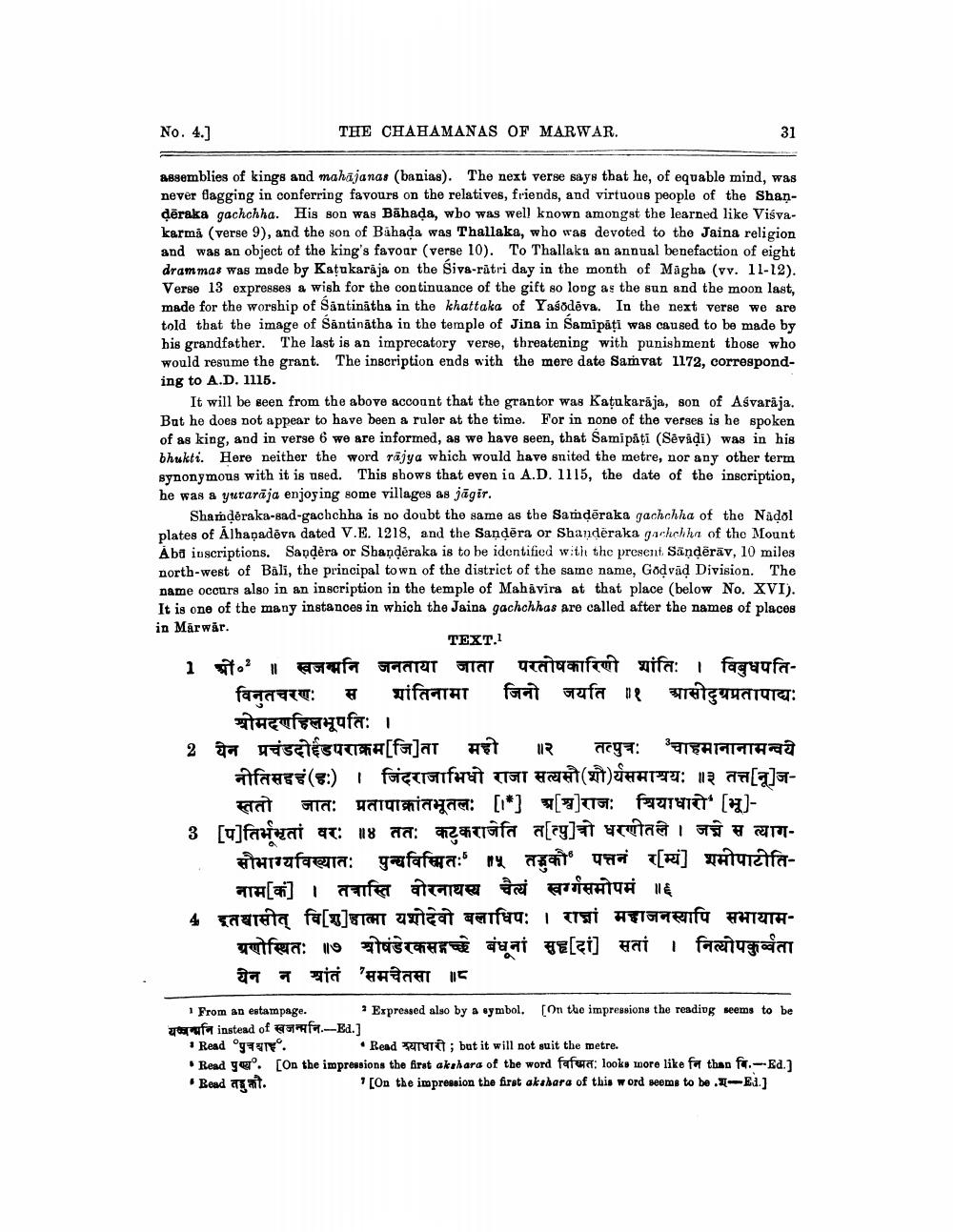________________
No. 4.]
THE CHAHAMANAS OF MARWAR.
31
assemblies of kings and mahajanas (banias). The next verse says that he, of equable mind, was never tagging in conferring favours on the relatives, friends, and virtuous people of the Shandēraka gachchha. His son was Bāhada, who was well known amongst the learned like Viśvakarmi (verse 9), and the son of Bihada was Thallaka, who was devoted to the Jaina religion and was an object of the king's favoar (verse 10). To Thallaka an annual benefaction of eight drammas was made by Katukaraja on the Sivs-ratriday in the month of Magha (vv. 11-12). Verse 13 expresses a wish for the continuance of the gift so long as the sun and the moon last, made for the worship of Santinātha in the khattaka of Yasodēva. In the next verse we are told that the image of Santinātha in the temple of Jing in Samipați was caused to be made by his grandfather. The last is an imprecatory verse, threatening with punishment those who would resume the grant. The inscription ends with the mere date Samvat 1172, corresponding to A.D. 1115.
It will be seen from the above account that the grantor was Katukarāja, son of Asvarāja. But he does not appear to have been a ruler at the time. For in none of the verges is he spoken of as king, and in verse 6 we are informed, as we have seen, that Samipati (Sevadi) was in his bhukti. Here neither the word rajya which would have snited the metre, nor any other term synonymous with it is used. This shows that even in A.D. 1115, the date of the inscription, he was a yurarāja enjoying some villages as jāgir.
Shamderaka-sad-gachchha is no doubt the same as the Samdēraka gachchha of the Nadol plates of Alhapadēva dated V.E. 1218, and the Sandēra or Shandëraka gachchha of the Mount Abd inscriptions. Sapdera or Shanderaka is to be identified with the present Sinderav, 10 miles north-west of Bali, the principal town of the district of the same name, Godvād Division. The name ocorre also in an inscription in the temple of Mahavira at that place (below No. XVI). It is one of the many instances in which the Jaina gachchhas are called after the names of places in Marwar.
TEXT.1 1 ओं० ॥ खजन्मनि जनताया जाता परतोषकारिणी शांतिः । विबधपति
विनुतचरणः स शांतिनामा जिनो जयति १ आसीदुग्रप्रतापाद्यः
श्रीमदणहिलभूपतिः । 2 येन प्रचंडदोईडपराक्रम[जि]ता मही र तत्पुत्र: चाहमानानामन्वये
नीतिसद्द(ह) । जिंदराजाभिधो राजा सत्यसौ(शौर्यसमाश्रयः ॥३ तत्त[न]ज
स्ततो जातः प्रतापाक्रांतभूतल: [*] अ[]राजः श्रियाधारो' [भू]3 [प]तिर्भूभृतां वरः ॥४ तत: कटुकराजेति त[त्पु]त्रो धरणीतले । जन्ने स त्याग
सौभाग्यविख्यात: पुन्यविस्मितः ॥५ तडको पत्तनं र[म्यं] शमीपाटीति
नाम[क] । तत्रास्ति वीरनाथस्य चैत्यं वर्गसमोपमं ॥ 4 इतथासीत् वि[शु]डात्मा यशोदेवो बलाधिपः । राज्ञां महाजनस्यापि सभायाम
ग्रणोस्थितः ॥७ थोडेरकसहच्छे बंधूनां सुह[दां] सतां । नित्योपकुर्वता येन न श्रांतं "समचेतसा ॥
From an estampage. Expressed also by a symbol. [On the impressions the reading seems to be यखन्अनि instead of स्वजन्मनि.-Ed.] - Read पुचवा.
• Read श्याधारी; but it will not suit the metre. . Read gero. [On the impressions the first akahara of the word fafua: looks more like fa than fr. -Ed. • Read तातो.
[On the impression the first akshara of this word seems to be.--El.]




